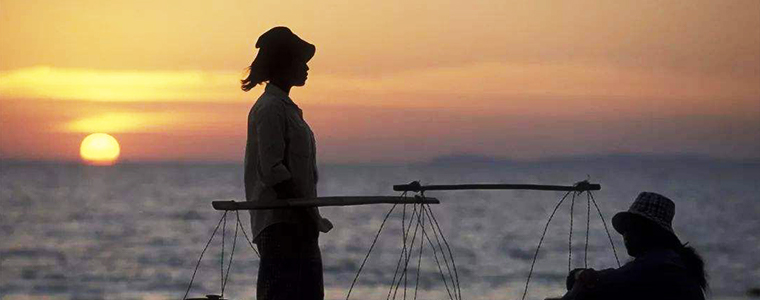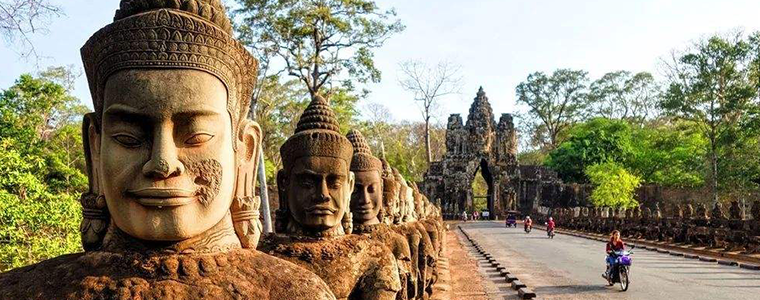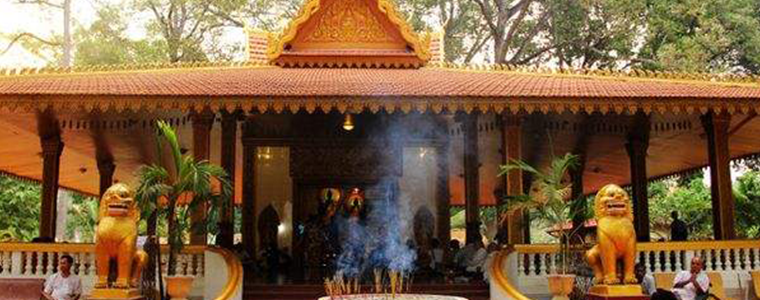FEEL THE WARMTH
The Kingdom of Cambodia, referred to as Cambodia, is located in theMainland Southeast Asia, bordering Thailand in the west and northwest, Laos inthe northeast, Vietnam in the east and southeast, and the Gulf of Thailand inthe south. The land area of Cambodia is 181035 square kilometers and has apopulation of about 16 million (as of April 2023). The country is divided into24 provinces and one municipality (Phnom Penh City). The capital of Phnom Penh,the Khmer people nationality accounts for 80% of the total population.
History
Cambodia hasa long history, with the earliest country being the Kingdom of Funan, alsoknown as the Kingdom of Mountains. In the 1st century AD, a foreigner led histroops to attack Funan and defeated the local Queen of Liu Yi. He married Queenof Liu Yi and became the first king of Funan. Funan Kingdom existed for 7centuries and was one of the most powerful kingdoms in early Southeast Asia. Itwas later destroyed by the Kingdom of Chenla, which existed for 9 centuries. TheAngkor Dynasty was the most powerful period in the history of Chenla, creatinga brilliant Angkor culture.
Language
Cambodian (also known as Khmer language) is the official language, andEnglish is commonly used in government departments. Chinese and Vietnameselanguage are the foreign languages most commonly used by ordinary citizens.
Religion
Religion holds a very important position in the political, social, anddaily lives of the Cambodian people. The Constitution stipulates that"both male and female citizens enjoy full freedom of belief, and the Stateprotects freedom of belief and religion", while also explicitly definingBuddhism as the state religion. People who believe in Hinayana account for morethan 85% of the population of the country. In addition, there are Christianity(approximately 36,000 followers) and Islam (approximately 320,000 followers). Buddhisttemples in Cambodia are spread throughout the country, and the social status ofmonks and king of monk is very high. Usually, regardless of their socialstatus, men have to become monks once in their lifetime, otherwise it isconsidered contemptuous by the secular world. However, they can return to thesecular world at any time, and after returning to the secular world, it iseasier to propose and find employment. [* Data source:Guidelines for Foreign Investment Cooperation Countries (Regions) Cambodia(2022 Edition)]
Culture
Cambodian people pay attention to etiquette andpoliteness. The most common etiquette is the Namaskar, which means putting yourhands together in front of your chest, slightly bowing your head, and theheight of your fingertips depending on the other person's identity. For kings,members of the royal family, and monks, squatting or kneeling down to worshipis also performed. Shaking hands is also popular in social occasions, but it isstill advisable to practice the Namaskar ceremony between men and women. TheCambodian marriage custom is for a man to "marry" into the woman'shouse. All the wedding ceremonies are held at the woman's home, and the weddingis presided over by the most prestigious elderly person in the village. Thetraditional housing of Cambodians is mostly bamboo and wood structured highstilted houses, about two meters above the ground, with people living on topand agricultural tools and vehicles stored below.
Dress
Due to their tropical location, Cambodian clothingis very thin. Their national casual wear is that men wear straight necked multibutton tops, and when the weather is hot, they do not wear tops, only wearing" sarong " or " Sampot ". Sarong is a fabric that isstitched together on both sides with various beautiful patterns printed severalfeet long, and is tied around the waist, resembling a skirt. Sampot is a longpiece of fabric that is not sewn up, wrapped from the waist down to the calves,and then passed through the crotch, tightly tied to the waist at the back, withthe remaining part protruding like a fish's tail. Women's casual tops aremostly silk round necked short sleeved shirts with a front and back, and theyalso wear " sarong " or " Sampot " at the bottom. Usually,they also wrap a beautifully patterned long cloth scarf around their waist.
Diet
Cambodian people mainly eat rice as their staple food and fish andshrimp as their main side dishes. They enjoy eating vegetables with stimulatingflavors, such as raw chili peppers, scallions, ginger, etc. They also like toeat lettuce, raw meat, and pickled fish sauce.
Cultural Heritage
World Heritage Sites: Angkor Wat, Preah Vihear Temple, Temple Zone ofSambor Prei Kuk, Archaeological Site of Ancient Ishanapura
World Intangible Cultural Heritage: Cambodian Royal Dance, Khmer ShadowTheater of Sbek Thom, CambodianTug-of-War, Khmer Chapei Dang Veng, Cambodia's oldest surviving story of InavBospa, Lkhon Khol Wat Svay Andet, kun bokator
Memory of the World Register: Tuol Sleng Genocide Museum
Memory of the World Asia-Pacific Register: Audio of Ta Krut's Ramayana(Reamker)
Traditional Festival
The main festivals in Cambodian New Year include:New Year's Day (January 1), Victory Day (January 7), International Women's Day(March 8), Khmer New Year, International Labour Day (May 1), Visak Bochea,Imperial Ploughing Festival, King's Birthday (May 14), International Children'sDay (June 1), Queen's Birthday (June 18), Constitutional Day (September 24),Pchum Ben Day, King's Throne Day (October 29), Independence Day (November 9),Water Festival. Saturday and Sunday are statutory public holidays.
Khmer NewYear
Cambodian New Year is known as the Songkran Festival or Water Festivalin Southeast Asia, which is usually held in the middle of April. For three daysof New Year celebration, Cambodians offer incense to the temple, clean housesand sweep dust, and exchange gifts. People wave water and sprinkle talcumpowder on each other. The Wat Phnom in Phnom Penh and Angkor Wat in Siem Reapare the main places for celebration.
Chat Preah Nengkal
Imperial Ploughing Festival is a traditional festival in Cambodia,usually held in May of the Gregorian calendar. Imperial Ploughing Festival is atraditional agricultural festival held under the leadership of members of theroyal family, marking the beginning of the traditional rice planting season.
Pchum Ben
The Cambodian Pchum Ben Day is held from October 1st to 15th every yearin the Buddhist calendar, lasting for a total of 15 days. The last three daysof the festival are legal holidays. During the Pchum Ben Day, from king toordinary people, traditional Buddhist customs are celebrated. Devout men andwomen gather in Buddhist alms and listen to monks reciting scriptures.
Bon Om Tuk
The most important traditional festival in Cambodia. Usually held fromOctober to November each year, this festival is a traditional Cambodianfestival that marks the end of the rainy season and the arrival of the fishingseason throughout the year.









